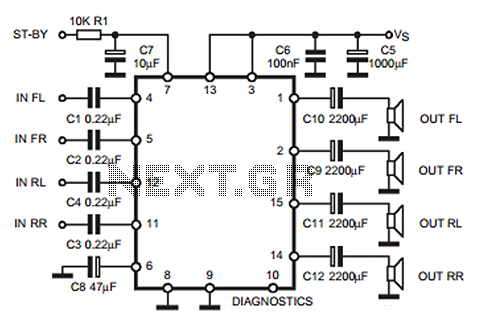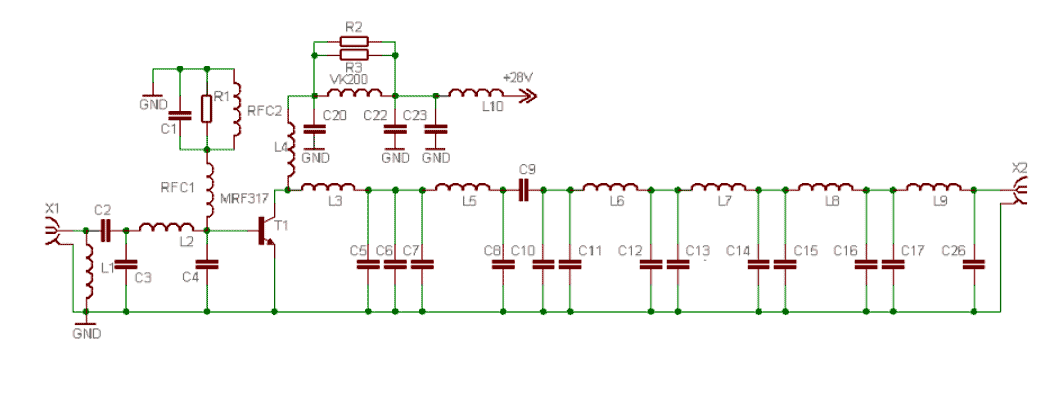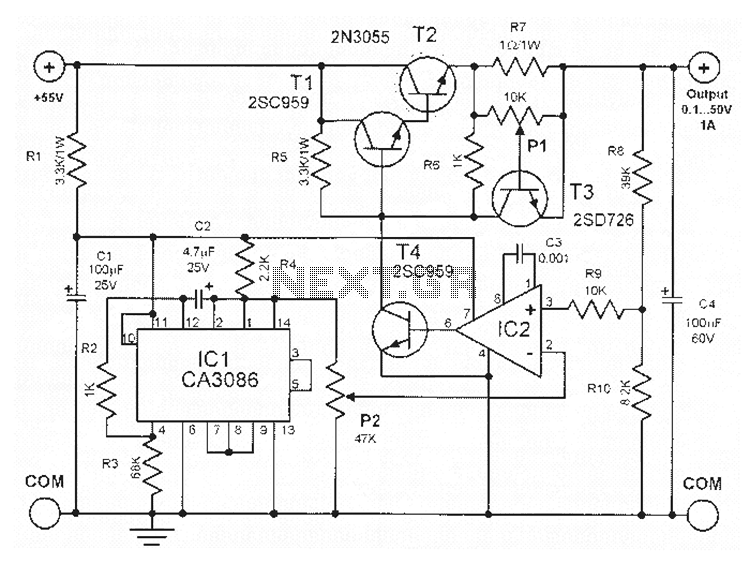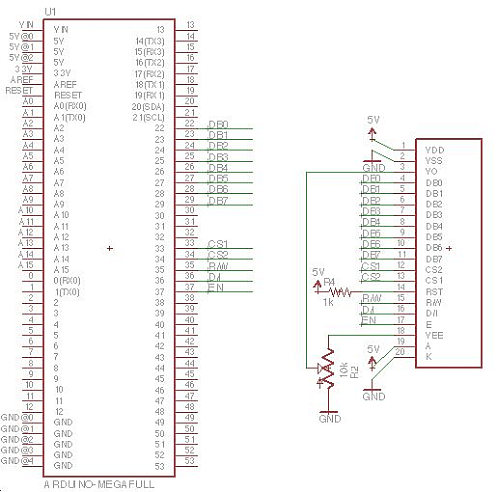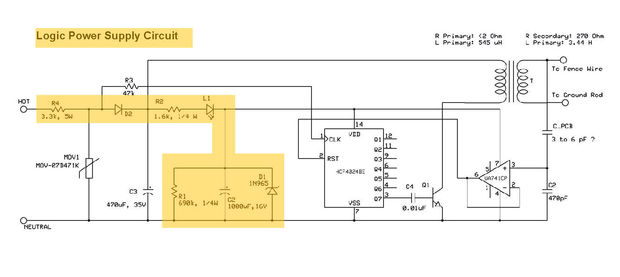
30 Watt Audio Power Amplifier Schematic
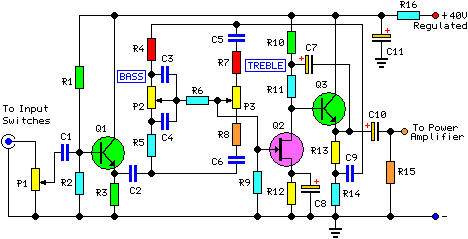
This project involved designing an audio amplifier capable of delivering substantial output power with a minimal number of components while maintaining quality. The power amplifier section consists of three transistors and a few resistors and capacitors configured in a shunt feedback arrangement, capable of exceeding 18W into an 8 Ohm load with a total harmonic distortion (THD) of 0.08% at 1KHz at the onset of clipping (0.04% at 1W - 1KHz and 0.02% at 1W - 10KHz), and up to 30W into a 4 Ohm load. To achieve such performance and ensure the overall stability of this simple circuit, a regulated DC power supply is essential. This requirement is advantageous as it helps maintain low noise and hum levels in the preamp and guarantees predictable output power across various load impedances. The amplifier operates on a single rail supply, allowing for the implementation of an efficient DC voltage regulator capable of providing over 2 Amps at 40V with minimal components. To measure the current, it is recommended to switch off the supply, disconnect the multimeter, reconnect it, and set it to measure at least 1 Amp full-scale deflection in series with the positive supply. Using a second multimeter in this setup is beneficial. For those with access to an oscilloscope and a 1KHz sine wave generator, the amplifier can be driven to maximum output power while adjusting R3 to achieve symmetrical clipping of the displayed sine wave. The preamp's sensitivity and overload margin are designed to accommodate most modern audio sources, including CD players, tape recorders, iPods, computer audio outputs, and tuners. The configuration of source selection switches and input connectors is left to the constructor's discretion. To ensure a high input overload margin, the volume control is positioned at the preamp input. Following a unity gain impedance converter stage (Q1), a negative feedback Baxandall-type bass and treble tone control stage is incorporated. This stage requires some gain (approximately 5.6 times) and employs a low-noise, bootstrapped two-transistor circuit with FET input, achieving excellent THD figures up to 4V RMS output and a low output impedance suitable for driving the Mini-MosFet power amplifier, as well as for other applications. A robust regulated power supply section is created by adding a PNP power transistor to the LM317T adjustable regulator chip, enabling the circuit to deliver more than sufficient power to drive two Mini-MosFet amplifiers to full output (at least 2 Amps at 40V into a 4 Ohm load) without noticeable strain. A power transformer with a secondary winding rated at 35-36V and 50VA (approximately 1.4 Amps) is required for use with 8 Ohm nominal impedance loudspeaker cabinets. For driving 4 Ohm loads at high power levels, a transformer rated at 70-75VA (at least 2 Amps) is preferable. These transformers are typically center-tapped, with the central lead left open. In the stereo version of this project, R16 and C11 in the preamp will be shared between both channels, necessitating only one of each component. In this case, R16 should be a 1.5K 1/2W resistor, while the value of C11 remains unchanged.
The audio amplifier circuit is designed with a focus on simplicity and efficiency, utilizing a minimal parts count to achieve high performance. The three-transistor amplifier stage operates in a class AB configuration, allowing for efficient power delivery and reduced heat generation. The choice of a shunt feedback configuration enhances linearity and stability, contributing to the low THD figures observed during testing.
The regulated power supply is a critical component, providing a stable voltage to the amplifier and preamp stages, ensuring consistent performance across varying load conditions. The LM317T voltage regulator, augmented with a PNP transistor, allows for the handling of higher current demands while maintaining regulation. The power supply design also includes filtering capacitors to further reduce ripple and noise, enhancing the overall audio quality.
The preamp section is equipped with a Baxandall tone control circuit, allowing users to adjust bass and treble frequencies to their preference. This stage is designed to maintain low noise levels while providing sufficient gain to drive the power amplifier effectively. The bootstrapped design of the tone control stage minimizes distortion and maintains a low output impedance, ensuring compatibility with the subsequent amplifier stage.
In summary, the audio amplifier project showcases an efficient design that balances performance and simplicity. By employing a regulated power supply and a minimalistic approach to component selection, the circuit achieves impressive audio fidelity suitable for a wide range of audio sources. The flexibility in the design allows for customization, making it adaptable to various applications while maintaining high-quality audio output.This project was a sort of challenge: designing an audio amplifier capable of delivering a decent output power with a minimum parts count, without sacrificing quality. The Power Amplifier section employs only three transistors and a handful of resistors and capacitors in a shunt feedback configuration but can deliver more than 18W into 8 Ohm with
0. 08% THD @ 1KHz at the onset of clipping (0. 04% @ 1W - 1KHz and 0. 02% @ 1W - 10KHz) and up to 30W into a 4 Ohm load. To obtain such a performance and to ensure overall stability of this very simple circuitry, a suitable regulated dc power supply is mandatory. This is not a snag because it also helps in keeping noise and hum of the preamp to very low levels and guarantees a predictable output power into different load impedance.
Finally, as the amplifier requires only a single rail supply, a very good dc voltage regulator capable of supplying more than 2 Amps @ 40V can be implemented with a few parts also. Switch off the supply, disconnect the Multimeter and reconnect it, set to measure at least 1Amp fsd, in series to the positive supply (the possible use of a second Multimeter in this place will be very welcomed).
Those lucky enough to reach an oscilloscope and a 1KHz sine wave generator, can drive the amplifier to the maximum output power and adjust R3 in order to obtain a symmetrical clipping of the sine wave displayed. The Preamp sensitivity and overload margin were designed to cope with most modern music program sources like CD players, Tape recorders, iPods, Computer audio outputs, Tuners etc.
The source selecting switches and input connectors are not shown and their number and arrangement are left to the constructor`s choice. To obtain a very high input overload margin, the volume control was placed at the preamp input. After a unity gain, impedance converter stage (Q1) a negative-feedback Baxandall-type Bass and Treble tone control stage was added.
As this stage must provide some gain (about 5. 6 times) a very low noise, "bootstrapped" two-transistors circuitry with FET-input was implemented. This stage features also excellent THD figures up to 4V RMS output and a low output impedance, necessary to drive properly the Mini-MosFet Power Amplifier, but can also be used for other purposes. A very good and powerful Regulated Power Supply section was implemented by simply adding a PNP power transistor to the excellent LM317T adjustable regulator chip.
In this way this circuit was able to deliver much more than the power required to drive two Mini-MosFet amplifiers to full output (at least 2Amp @ 40V into 4 Ohm load) without any appreciable effort. A power Transformer having a secondary winding rated at 35 - 36V and 50VA (i. e. about 1. 4Amp) is required if you intend to use Loudspeaker cabinets of 8 Ohm nominal impedance. To drive 4 Ohm loads at high power levels, a 70 - 75VA Transformer (2Amp at least) will be a better choice.
These transformers are usually center tapped: the central lead will be obviously left open. For the stereo version of this project, R16 and C11 in the Preamp will be in common to both channels: therefore, only one item each is necessary. In this case, R16 must be a 1K5 1/2W resistor. The value of C11 will remain unchanged. 🔗 External reference
The audio amplifier circuit is designed with a focus on simplicity and efficiency, utilizing a minimal parts count to achieve high performance. The three-transistor amplifier stage operates in a class AB configuration, allowing for efficient power delivery and reduced heat generation. The choice of a shunt feedback configuration enhances linearity and stability, contributing to the low THD figures observed during testing.
The regulated power supply is a critical component, providing a stable voltage to the amplifier and preamp stages, ensuring consistent performance across varying load conditions. The LM317T voltage regulator, augmented with a PNP transistor, allows for the handling of higher current demands while maintaining regulation. The power supply design also includes filtering capacitors to further reduce ripple and noise, enhancing the overall audio quality.
The preamp section is equipped with a Baxandall tone control circuit, allowing users to adjust bass and treble frequencies to their preference. This stage is designed to maintain low noise levels while providing sufficient gain to drive the power amplifier effectively. The bootstrapped design of the tone control stage minimizes distortion and maintains a low output impedance, ensuring compatibility with the subsequent amplifier stage.
In summary, the audio amplifier project showcases an efficient design that balances performance and simplicity. By employing a regulated power supply and a minimalistic approach to component selection, the circuit achieves impressive audio fidelity suitable for a wide range of audio sources. The flexibility in the design allows for customization, making it adaptable to various applications while maintaining high-quality audio output.This project was a sort of challenge: designing an audio amplifier capable of delivering a decent output power with a minimum parts count, without sacrificing quality. The Power Amplifier section employs only three transistors and a handful of resistors and capacitors in a shunt feedback configuration but can deliver more than 18W into 8 Ohm with
0. 08% THD @ 1KHz at the onset of clipping (0. 04% @ 1W - 1KHz and 0. 02% @ 1W - 10KHz) and up to 30W into a 4 Ohm load. To obtain such a performance and to ensure overall stability of this very simple circuitry, a suitable regulated dc power supply is mandatory. This is not a snag because it also helps in keeping noise and hum of the preamp to very low levels and guarantees a predictable output power into different load impedance.
Finally, as the amplifier requires only a single rail supply, a very good dc voltage regulator capable of supplying more than 2 Amps @ 40V can be implemented with a few parts also. Switch off the supply, disconnect the Multimeter and reconnect it, set to measure at least 1Amp fsd, in series to the positive supply (the possible use of a second Multimeter in this place will be very welcomed).
Those lucky enough to reach an oscilloscope and a 1KHz sine wave generator, can drive the amplifier to the maximum output power and adjust R3 in order to obtain a symmetrical clipping of the sine wave displayed. The Preamp sensitivity and overload margin were designed to cope with most modern music program sources like CD players, Tape recorders, iPods, Computer audio outputs, Tuners etc.
The source selecting switches and input connectors are not shown and their number and arrangement are left to the constructor`s choice. To obtain a very high input overload margin, the volume control was placed at the preamp input. After a unity gain, impedance converter stage (Q1) a negative-feedback Baxandall-type Bass and Treble tone control stage was added.
As this stage must provide some gain (about 5. 6 times) a very low noise, "bootstrapped" two-transistors circuitry with FET-input was implemented. This stage features also excellent THD figures up to 4V RMS output and a low output impedance, necessary to drive properly the Mini-MosFet Power Amplifier, but can also be used for other purposes. A very good and powerful Regulated Power Supply section was implemented by simply adding a PNP power transistor to the excellent LM317T adjustable regulator chip.
In this way this circuit was able to deliver much more than the power required to drive two Mini-MosFet amplifiers to full output (at least 2Amp @ 40V into 4 Ohm load) without any appreciable effort. A power Transformer having a secondary winding rated at 35 - 36V and 50VA (i. e. about 1. 4Amp) is required if you intend to use Loudspeaker cabinets of 8 Ohm nominal impedance. To drive 4 Ohm loads at high power levels, a 70 - 75VA Transformer (2Amp at least) will be a better choice.
These transformers are usually center tapped: the central lead will be obviously left open. For the stereo version of this project, R16 and C11 in the Preamp will be in common to both channels: therefore, only one item each is necessary. In this case, R16 must be a 1K5 1/2W resistor. The value of C11 will remain unchanged. 🔗 External reference
